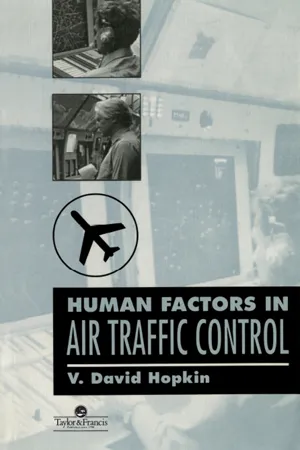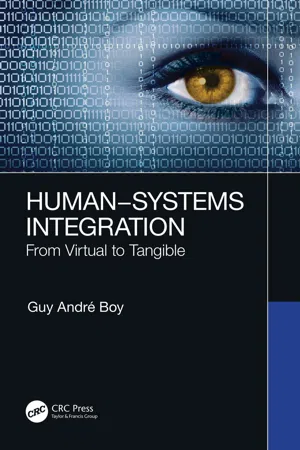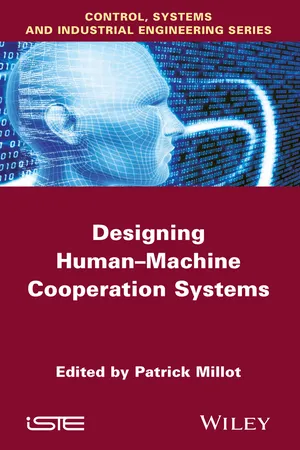Technology & Engineering
Human Machine System
A human-machine system refers to the interaction and integration of humans and machines to perform tasks or achieve goals. It encompasses the design, operation, and management of technology to optimize human performance and enhance overall system efficiency. This concept emphasizes the interconnectedness and interdependence of humans and machines in various technological and engineering applications.
Written by Perlego with AI-assistance
Related key terms
4 Key excerpts on "Human Machine System"
- eBook - ePub
- V. D. Hopkin(Author)
- 2017(Publication Date)
- CRC Press(Publisher)
3 The human as a system component 3.1 Limitations of the concept A system in which numerous human operators collaborate with machines to fulfil the designated objectives of the system as a whole was originally called a man-machine system (Parsons, 1972), a concept now deemed sexist. This text generally employs the term “human–machine system”, although it lacks universal acceptance. All the humans within the same system do not normally have identical tasks, jobs, equipment or functions, but they may share the same professional knowledge and qualifications and sometimes the same training. Nowadays, the machines almost invariably include computer hardware and software. Studies of human–machine systems can be of real systems, of simulated or prototype systems in real time or fast time, of planned systems, or of hypothetical systems. They may aim to assess feasibility, efficiency, safety, practicality, reliability or capacity. They can be exercises in modelling, quality control, operational research, risk analysis, optimization, quantification, validation, or cost-effectiveness. They may examine procedures, innovations, changes, errors, or failures. An air traffic control system is one example of a human–machine system. The description of an entire functioning system must employ language, notations and constructs that can be applied to all its components, to the interactions between them, and to the system structure and integrality (Wise et al., 1993). Exclusively human concepts cannot suffice, no matter how anthro-pomorphic the descriptions of machines become. Engineering concepts, mathematical concepts and computer concepts have all been enlisted to describe human–machine systems, and have seemed feasible in so far as they can accommodate times, events, probabilities, associations, dependencies, and error and failure rates - Lynne J Millward(Author)
- 2005(Publication Date)
- SAGE Publications Ltd(Publisher)
7Human–Machine Interaction
If one views technology not simply as hardware but as a process in which flows of knowledge and artefacts are generated and diffused through the process of invention, use and exchange, it is clear that an individual organisation is itself but one site for the shaping of the technology that it applies.(Corbett, 1994: 207)Preface
Widespread adoption of computer technology for everyday work, coupled with increased automation of jobs (across manufacturing and service sectors) and advances in microprocessor-based technology, have heightened the salience of the interface between employees and machines. The design of human–machine systems and artefacts is ever more critical to individual and, ultimately, organizational performance. The study of the human–machine interface can be approached from a range of disciplines such as engineering, physics, mathematics, design, computing, and cognitive, environmental, experimental and social psychology. Here the study of human–machine interaction in workplace settings is examined from an occupational psychology perspective. The increased use of computer technology has prompted attention in particular to the cognitive elements of ergonomic ‘fit’ between humans and machines, in addition to the traditional focus on physical and physiological factors. This includes the study of the impact of automation as well as other more advanced technologies on human users. Hence, whilst some may assign the topic of human–machine interaction to the ergonomics expert, psychologists are to be encouraged to take a unitary approach to this issue, taking into account human factors at both a job and organizational level as well as the machine side of the equation.Cognitive developments in connection with understanding the human–machine interface have burgeoned interest in the mental model concept, and the possibility that mental models can be distributed across both people and artefacts comprising a single cognitive system. The optimal use of technology is inextricably tied up with cognition. A digital scenario in particular requires a prerequisite cognitive capability. As stressed by Jafee (2001), new forms of skill and knowledge may be required to exploit new technology. Intelligence is not- eBook - ePub
Human–Systems Integration
From Virtual to Tangible
- Guy André Boy(Author)
- 2020(Publication Date)
- CRC Press(Publisher)
1 INCOSE HSI Working Group definition of Human–Systems Integration (HSI) is the following: “HSI is an interdisciplinary technical and management process for integrating human and organizational considerations with and across all system elements, an essential enabler to systems engineering practice. Human activity considered by HSI includes designing, modeling and simulation, engineering, operating, maintaining, supporting and dismantling the system. HSI also considers training and training devices, as well as the infrastructure used for operations and support (DAU, 2010). HSI incorporates the following domains as integration considerations: manpower, personnel, training, human-centered design, human factors engineering, occupational health, environment, safety, habitability, and human survivability.”Human-in-the-loop evaluation is always beneficial to the discovery of emerging behaviors and properties, because it enables evaluation of human’s actions and organizational capacity and support. Evaluation metrics have to be defined, standardized, and further used within an organization. More specifically, human performance has to be measured using performance metrics, such as accuracy, workload, situation awareness, cognition, personality, emotional health, physiology, and biomechanics.Systemic representation: structure and function | human and machine | cognitive and physical
HSI cannot be properly defined without defining what the concept of “system” really is about. The definition presented in this section breaks with traditional meaning of system conceived as a machine only but instead encapsulating humans, organizations, and machines.2First of all, a system is a representation of- A human or more generally a natural entity (e.g., a bird, a vegetal)
- An organization or a social group (e.g., a team, a community)
- A machine or a technological entity (e.g., a car, a motorway).
A system has at least a structure and a functionA system is a system of systems , which means that a system includes people, machines, and systems. This recursive definition is crucial to be clearly understood. A system is multi-agent in the artificial intelligence (AI) sense; an agent being a society of agents. - eBook - ePub
- Patrick Millot(Author)
- 2014(Publication Date)
- Wiley-ISTE(Publisher)
1.5. Conclusion
This chapter asks the question of the role of humans in the human–machine system, and, more generally, the principle of human-centered design to answer this. The success of this design makes it imperative that humans, with all their characteristics, must be taken into account at the very beginning, and throughout the design process.The human must be considered an element that not only interacts with the system by carrying out tasks (or more precisely activities), but which is also placed in an organization and deals with work situations. The organizational aspects are of high importance when we want to define the level of automation of the human–machine system, in particular the allocation of functions and tasks between human and machine. The principles of authority and responsibility must therefore be respected inexorably.In fact, human-centered design aims to reconcile two apparently antagonist behaviors: the imperfect human, who can correct and learn from his errors, and the attentive, and inventive human capable of detecting problems and bringing solutions even if they are difficult and new. The desire for control of the imperfect human tends to lead to procedures, the result of returns on experience, i.e. a form of automation of the human activity. However, this “proceduralization” of human activity does not favor vigilance and inventiveness and therefore goes against the human qualities that justify keeping the operators active in the loop.At the opposite end, favoring human SA maintains attention, vigilance and inventiveness. With this goal, human resources can be amplified by tools to support with decision and action. The integration of such tools leads again to the question of the level of automation, since these tools could become real decision partners and even real cooperators for humans, as we will see in the last chapters.1.6. Bibliography
Learn about this page
Index pages curate the most relevant extracts from our library of academic textbooks. They’ve been created using an in-house natural language model (NLM), each adding context and meaning to key research topics.



